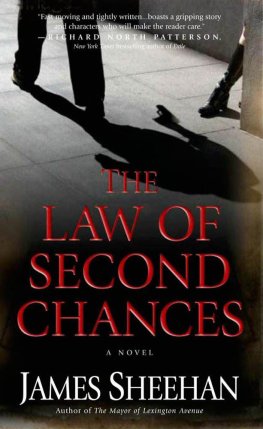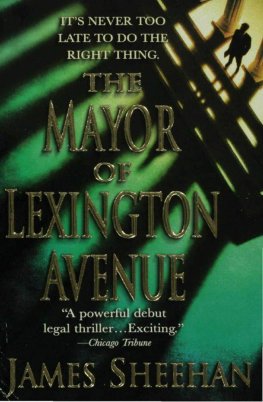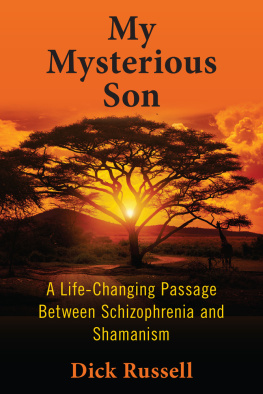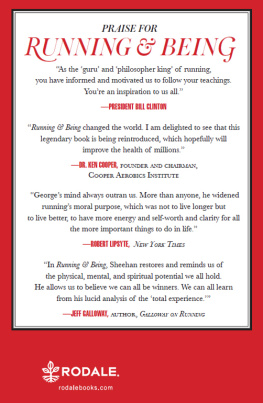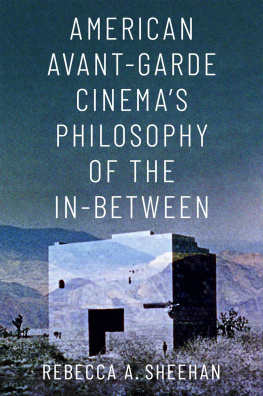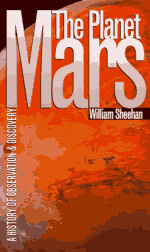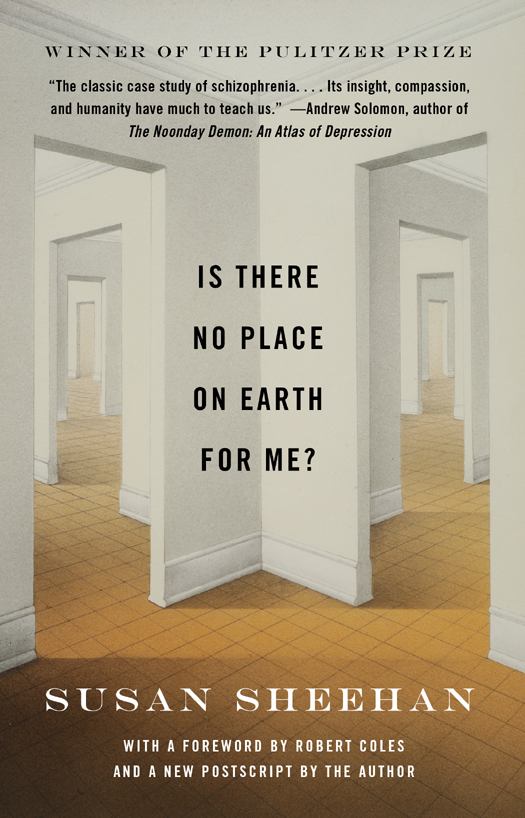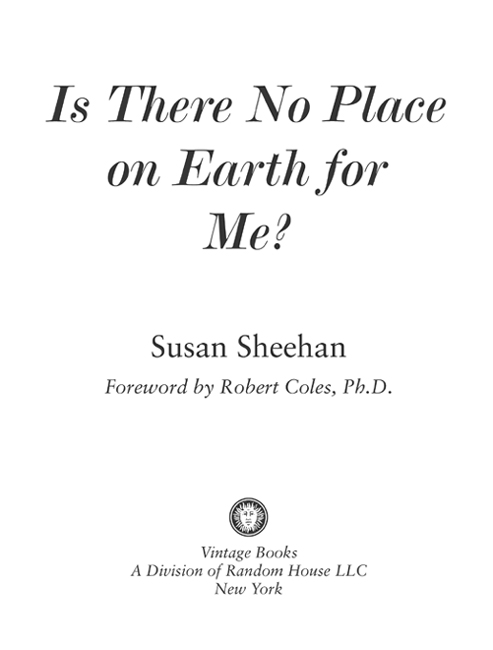Praise for Susan Sheehans
Is There No Place on Earth for Me?
I would want him [the president of the United States] to read Is There No Place on Earth for Me?, Susan Sheehans great nonfiction book about a young schizophrenic woman. It really conveys the grinding wheel of mental illness.
David Sedaris,
The New York Times Magazine (2012)
Susan Sheehan has committed an extraordinary act of journalism. She brings relentless intelligent attention to bear on a particular case, a journalistic practice that almost always results in new and disturbing insights into those mindless generalities and prejudice and certitudes we tend to carry around with us.
The Washington Post Book World
Sheehan is tenacious, observant and unsentimental. The history of a single patient leads us into a maze of understaffed institutions, bureaucratic fumbling, trial-and-error treatment and familial incomprehension. Though Sheehan keeps herself invisible, her sympathy is palpable.
Newsweek
[A] monumental piece of reportage. A model of close-up journalism: totally convincing, unsentimental yet obviously compassionate, rigorously plain.
Kirkus Reviews
This is the classic case study of schizophrenia that set the stage for reform in the mental health system and for a larger public understanding of the condition. Even thirty years later, its insight, compassion and humanity have much to teach us.
Andrew Solomon, author of The Noonday Demon: An Atlas of Depression
SECOND VINTAGE BOOKS EDITION, JANUARY 2014
Copyright 1982, 1995 by Susan Sheehan
Foreword copyright1982 by Robert Coles
All rights reserved. Published in the United States by Vintage Books, a division of Random House LLC, New York, and in Canada by Random House of Canada, Limited, Penguin Random House Companies. Originally published in somewhat different form in hardcover in the United States by Houghton Mifflin, Inc., New York, in 1982. Subsequently published in paperback by Vintage Books, a division of Random House LLC, in 1983.
Vintage and colophon are registered trademarks of Random House LLC.
Most of the contents of this book originally appeared, in slightly different form, in The New Yorker.
Library of Congress Cataloging-in-Publication Data
Sheehan, Susan.
Is there no place on earth for me?
Originally appeared, in slightly different form, in the New Yorker.
Reprint. Originally published: Boston: Houghton Mifflin, 1982.
1. SchizophrenicsUnited StatesBiography. 2. Frumkin, Sylvia. 3. Creedmoor Psychiatric Center.
I. Title.
[RC514.S49 1983] 616.8982.0924[B] 82-40424
Vintage Trade Paperback ISBN: 978-0-8041-6918-9
eBook ISBN: 978-0-8041-6919-6
www.vintagebooks.com
Cover design by Abby Weintraub
Cover illustration by Fred Marcellino used with the permission of Pippin Properties, Inc.
v3.1
For Maria Gregory Sheehan
and, for this new edition,
for our two grandsons, Nicholas and Andrew Bruno
Contents
Foreword
Robert Coles, Ph.D.
Is there no place on earth for me? has been asked by countless men and women who have never seen a psychiatrist or spent time in a mental hospital. Children the world over quite commonly ask themselves and their parents terribly provocative and haunting questions questions that are certainly existentialist, in that they are aimed at comprehending lifes mysteries. After a while, though, many of us give up and immerse ourselves in the ebb and flow of a particular existence. It is left to our writers and our artists, not to mention our scientists, to keep alive the intense curiosity, the disarming awe, the unashamed and driven wonder that so often characterize nursery-school children as they pester and plead for answers. Gauguins powerful painting Where do we come from? What are we? Where are we going? was finished in 1897, just before the aging artist, shut off and fearful, ailing physically and low in spirits, attempted (in an act of desperation) to kill himself by taking arsenic. His paintings showed, nevertheless, how alive he was, how attentive still to the kind of moral and psychological inquiry it is in our nature to make.
Most of us are not granted the genius of a Gauguin, or of, say, a philosophical novelist or a metaphysical poet the genius of men and women who transform their questions into inspired canvases or words. But even those of us with the least intellectual or artistic inclinations can still, by virtue of our humanity, ask the most thoughtful questions. Nor does craziness destroy that capacity; indeed, many men and women wrestle with the meaning of things even while they spend years struggling with terrible fears, with haunting doubts, with delusions and hallucinations that wont go away despite the assurances of doctors and the pills and electric shocks that doctors prescribe.
When I was a psychiatric resident, a patient of mine, a janitor, told me: Ive no education, and Im loony. I know it, but I still stop and look around and try to figure out whats happening to me, and to these crazy doctors who take care of us crazy patients. Im not a dog, a rat not yet! The downward slope of his mental life was such that, upon occasion, he was convinced that a long dead puppy dog, a childhood acquaintance, lived inside his mind and craved expression hence the abrupt, mournful barks we who attended him would sometimes hear. At other times, however, we saw a mans searching, reflective mind at work, now and then exerting itself more strenuously than might have been the case had he not been plagued by demons within. One can say this without romanticizing madness as some have done in recent years, without falsely proclaiming it a royal road to truth and wisdom.
Readers of The New Yorker met Sylvia Frumkin in the spring of 1981, and readers of this book will soon enough get to know her extraordinarily well, because of a particular writers observational and literary gifts. Miss Frumkin turns out to be an extremely troubled person whose mind doesnt work, in certain respects, the way most other minds work. The labels psychiatrists use to set Miss Frumkin apart, the diagnostic classifications applied to her, are merely matters of medical convenience or should be. We dont learn all that much about a patient when we are told that she is schizophrenic, but we do learn that certain aspects of her mental life are predictably exceptional. Most of us dont hear strange voices commanding us to do this or that. We dont see things that arent physically there while awake. We dont invent words and use them insistently, provocatively, to the consternation of our neighbors. We dont scream and shout and mumble over and over again for reasons no one can figure out. We dont talk in such a way that even our friends and relatives cant possibly ascertain what in the world we are saying, or mean to say. But Miss Frumkin and thousands upon thousands of other Americans, and millions the world over, have it as their lot to think and feel and behave in such a manner. Yet as we get to know Miss Frumkin we also see her as what? A seeker, a pilgrim. A person struggling earnestly and honestly with important moral issues. A shrewd observer of her fellow human creatures, no matter how wrong-headed her conclusions about them may be. It is a tribute to Susan Sheehan that her subject does not come across as yet another exhibit in the growing literary landscape of American grotesquerie.


